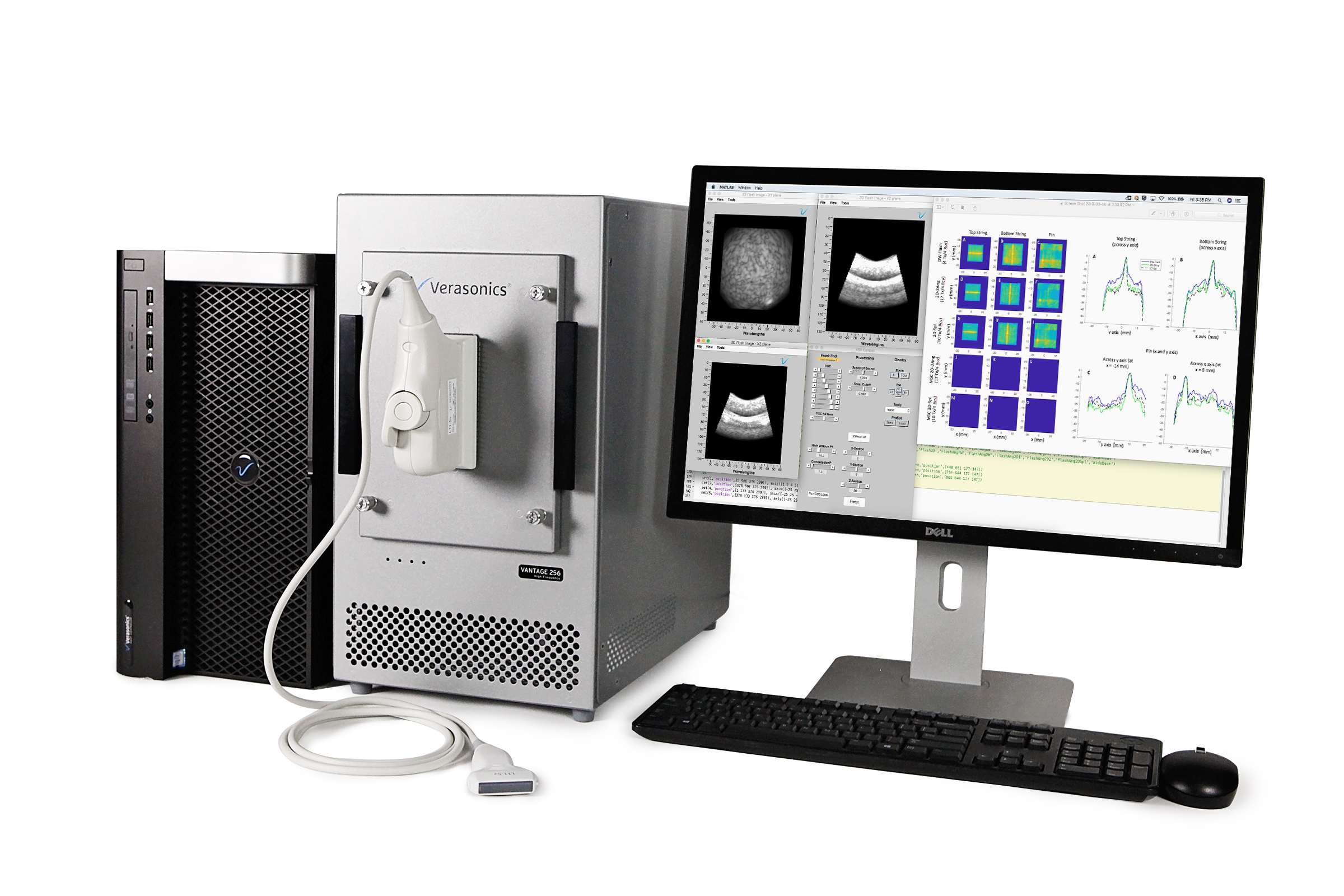Artificial Intelligence
Vantage Research Ultrasound’s Flexible Programming Model Facilitates
Cutting-Edge Research Using Artificial Intelligence (AI)
AI is a new and rapidly evolving technology that is revolutionizing many industrial and research areas. In particular, imaging modalities that use ultrasound-based technologies are highly suited for AI-based development. Today most researchers differentiate between Machine Learning (ML) and Deep Learning (DL).[i] Both are AI disciplines that use statistical methods to improve machine optimization and decision-making performance through experience. In particular, DL approaches which involve complex, biologically inspired neural networks (NN) such as convolutional NNs (CNNs), are rapidly-emerging research directions that demonstrate great promise in solving some key problems in ultrasound. DL is a relatively young field of AI and only became possible about a decade ago when new algorithms were developed to train the highly complex networks. With suitable training, these complex networks learn how to produce the desired outcome, and furthermore, they develop an effective model for the problem by extracting important hidden features from the data. This sophisticated signal processing approach makes DL an intriguing tool for complex and demanding applications such as ultrasound imaging. Recent research areas include super resolution, speckle reduction and image enhancement, and even image reconstruction from raw data. Many recent studies in these fields were conducted with the Vantage System. Alternatively, ML-based approaches are much older and date back to the 1990s[ii],[iii], and many research studies and commercial applications have demonstrated that they are a very useful tool as well. Applications range from tissue characterization and feature discrimination (e.g., Cancer detection [iv],[v]), computer aided diagnosis systems (CAD)[vi], to image segmentation[vii].
The Vantage system is an ideal platform for developing cutting-edge AI technologies for all aspects of ultrasound-based applications. With its powerful but easy-to-use programming model and design that utilizes the popular and widely-known Matlab® programming language and engineering environment, the Vantage system provides the researcher and developer with great versatility in defining each of the ultrasound system’s functional components. This exceptional flexibility is key for developing new AI-approaches.

In fact, a single researcher can easily conceive, implement, and evaluate new ML or DL approaches using the Vantage System. For example, the user has direct access to the RF-raw data and data at multiple points in the signal processing flow. This allows exploration of new DL approaches for beamforming and image reconstruction, general image enhancement, speckle reduction and super-resolution applications. Reconstructed b-mode image data or data from other imaging modes (e.g., Doppler or shear-wave imaging) can be used for developing and testing novel CAD systems, speckle tracking, tissue and object detection, or segmentation algorithms.
In particular, the use of Matlab® makes Vantage a powerful AI-research tool. Mathworks provides two toolboxes: one for ML and one for DL development. These popular toolboxes come with many examples, pre-developed code and models for training and classification, and thus provide well-documented and easy access into AI-research and applications. Furthermore, Matlab® supports many interfaces to other programming languages such as C, C++ and JAVA, allowing for integration with some of the most common AI-software libraries.
One of the most remarkable advantages of the Vantage System, is that it allows testing of novel AI-approaches in a real time imaging environment. The flexible programming model allows the user to define custom processing that can easily be integrated into the ultrasound sequence at any point. For example, a user can extract data for AI processing and place it back into the data flow for further built-in processing. Integration of high-performance languages such as C or C++ that support multi-threaded or Nvidia CUDA programming within Matlab® addresses the high computational demands of common DL algorithms.
Matlab® is a registered trademark of The MathWorks, Inc.
[i] Brattain LJ, et al. Machine learning for medical ultrasound: status, methods, and future opportunities. Abdom Radiol (NY). 2018;43(4):786–799. https://doi.org/10.1007/s00261-018-1517-0
[ii] Maclin PS, et al. Using an artificial neural network to diagnose hepatic masses. 1992 Oct;16(5):215-25. PMID: 1289469
[iii] Feleppa J E et al. Spectrum-Analysis and Neural Networks for Imaging to Detect and Treat Prostate Cancer, Ultrasoinc Imaging, 2001, https://doi.org/10.1177/016173460102300301
[iv] Feleppa J E et al., Quantitative ultrasound in cancer imaging. Semin Oncol. 2011 Feb;38(1):136-50. https://doi.org/10.1053/j.seminoncol.2010.11.006
[v] Rohrbach D et al., High-Frequency Quantitative Ultrasound for Imaging Prostate Cancer Using a Novel Micro-Ultrasound Scanner. Ultrasound Med Biol. 2018 Jul;44(7):1341-1354. https://doi.org/10.1016/j.ultrasmedbio.2018.02.014 Epub 2018 Apr 4.
[vi] Huang Q et al. Machine Learning in Ultrasound Computer-Aided Diagnostic Systems: A Survey Hindawi, BioMed Research International, Volume 2018, Article ID 5137904, 10 pages https://doi.org/10.1155/2018/5137904
[vii] Hadjercia O, et al., Computer-aided detection system for nerve identification using ultrasound images: A comparative study, Informatics in Medicine Unlocked Volume 3, 2016, Pages 29-43, https://doi.org/10.1016/j.imu.2016.06.003
11335 NE 122nd Way, Suite 100
Kirkland WA 98034

